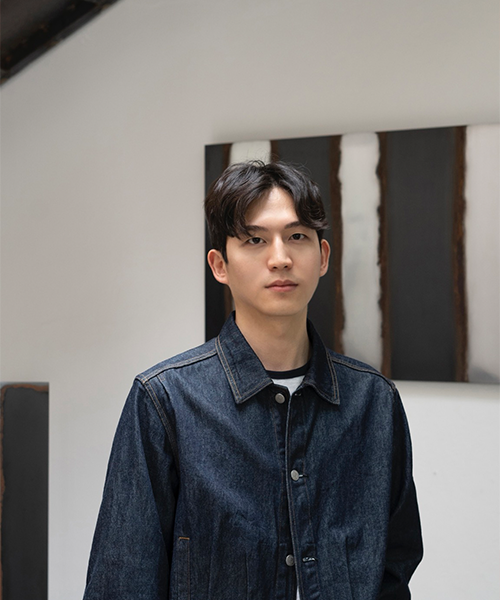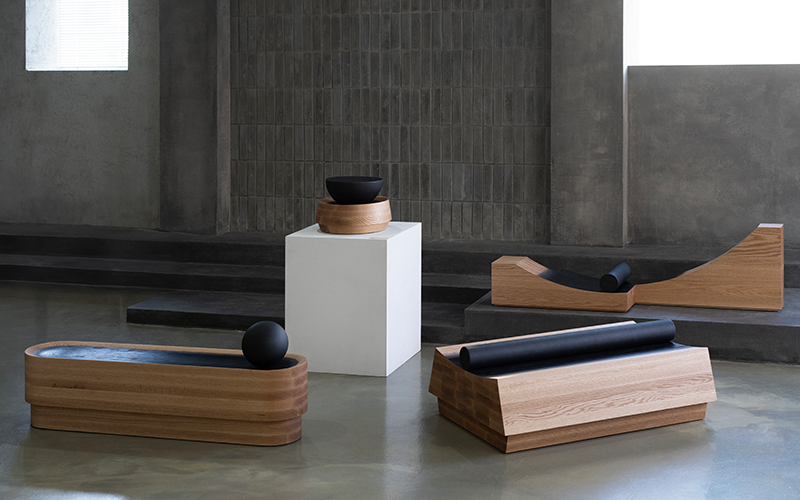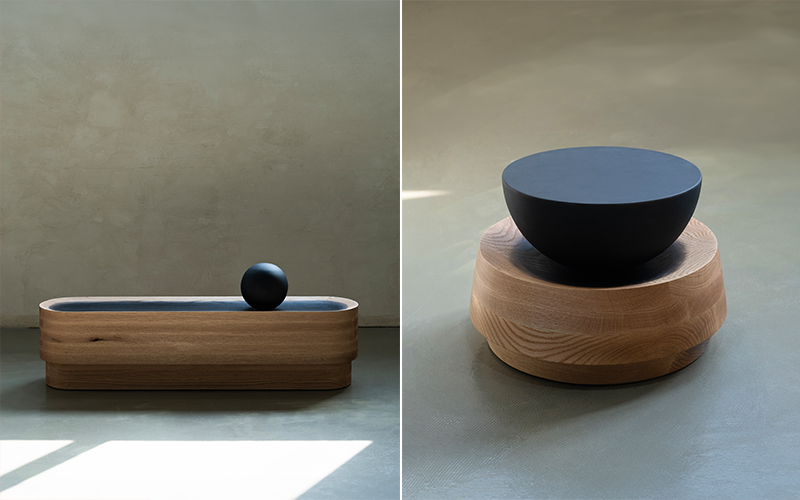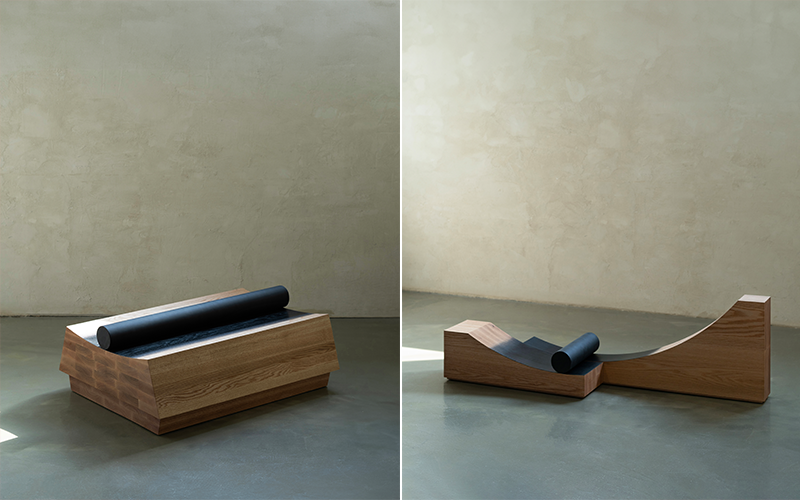[INTERVIEW] Artist on His Grand Prize-Winning Work at Cheongju International Craft Competition
2025-08-19The Cheongju International Craft Competition, held as part of the Cheongju Craft Biennale, is a global event that celebrates modern craft. It welcomes artists from all backgrounds and aims to highlight new talent and fresh ideas. On July 31, the 2025 Grand Prize was awarded to artist Lee Sipyeong for Log Series, a sculptural exploration of timber that reflects the cycle of growth, decay, and renewal. In an email interview between August 1 and 18, Lee shared stories about how he got started in art, the things that influenced his work, and what Log Series means to him.

Please introduce yourself.
My name is Sipyeong Lee. My work focuses on capturing the hidden aspects of objects and phenomena and translating them into visual symbols. Recently, I have been drawn to the idea of 'traces', the small marks that are left behind through the actions of materials in everyday life. I see traces as cues that encapsulate larger narratives, which we may not immediately recognize. My practice begins with freely imagining the unseen stories concealed beneath the surface by exploring the moments when certain events begin and the processes they undergo.
Can you share your journey into art and design, and how that has evolved?
My parents had stable careers, where my father worked in national intelligence, and my mother, a high school teacher. Hence, when I first shared my desire to pursue art, they strongly opposed the idea. I didn’t grow up around artists, yet their resistances made me realize how deeply I longed for art. Even after working at a design firm following college, I felt a growing need to create something of my own; hence, I eventually left that job and invested everything I had into my practice.
Not being understood by my family was difficult, but moving beyond it became a turning point. My younger sibling later chose a similar path, inspired by my decision. That journey taught me patience, quiet joy in the process, and trust in the lasting impact of the work itself.
Your work often explores the ‘unseen’ rather than the visible. How do you interpret these hidden aspects?
I don't see the 'invisible' as something that doesn’t exist, but rather as something that's waiting to be noticed. For instance, I recently noticed a worn edge of a metal railing near a traffic light, shining in the sun. Knowing the long wait times of that light, I imagined how many people had leaned on that spot over the years. More than metal, that small detail felt like a quiet witness to everyday life.
I believe materials around us carry hidden stories. Hence, instead of focusing on their physical traits, I try to create ways to uncover the intangible ideas they hold. My work often begins with ordinary objects or moments, using them for imagination and reflection. This shift in perspective is central to my practice.
How do you choose the materials you work with, and what role do they play in your creative process?
I’ve worked with a wide range of materials like wood, stone, metal, and leather, and a longtime friend’s advice has been instrumental in shaping my approach. In the early stages of my practice, I was fixated on working solely with metal, but my friend once told me, “If the story you want to tell is the priority, then you should choose the material and form that best serve that story.” That shifted the way I think and work. Each material holds distinct qualities, yet I avoid limiting them to conventional associations. Metal, often seen as cold, reveals warmth through oxidation. Whereas ceramics, though soft, can appear sharp depending on the finish. This is why I try to maintain an open attitude toward materials. Discovering unfamiliar aspects of a material, those I hadn’t previously noticed, is often a key starting point in my creative process.

What inspired the Log Series?
One day, while resting on a familiar park bench, I noticed deep black stains around the metal bolts. It reminded me of wooden chairs in an abandoned school from my childhood, where metal had left similar marks. I later learned that the discoloration comes from a chemical reaction, when iron salts from corroded metal react with tannins in the wood. As a woodworking student, this discovery felt profound, as it mirrored a technique called ebonizing, which darkens wood to resemble ebony.
What struck me was how this natural process, often seen as a simple finish, actually reflects a slow, time-based interaction between materials. Most people only see it as a technical finish, without noticing the story behind it. That inspired me to create a series that reveals this hidden narrative to those unfamiliar with woodworking, which is not just about a material response, but about time, touch, and the relationship between substances. That’s why I titled the series Log, which refers both to a tree trunk(wood) and to a record or journal. The series imagines the memories, traces, and silent history embedded within the wood itself.
Each work in the series: Spreading Far Away, Circling in Place, Repeating Endlessly, and Different Yet the Same, explores movement, interaction, and transformation. How did you approach these themes in each piece?
Each piece explores the interaction between different materials like metal and wood, through imagined, specific scenarios. I wanted to show how interaction is never fixed; it takes on varied forms depending on the environment and the nature of the relationship.
For example, Different Yet the Same is about two elements that begin from entirely different starting points, only to discover a shared intersection, a convergence toward the same narrative. Circling in Place, on the other hand, portrays a motion that loops continuously in one spot. It could be seen as a meditative stillness, or perhaps the frustration of circling through unresolved thoughts. That said, I try not to over-explain the works. Rather than offering definitive interpretations, I hope the titles, forms, and traces left behind serve as entry points for the viewer’s imagination. Each viewer can draw their meaning based on what they observe and feel.
The ebonizing technique plays a central role in the series, but it’s used more as a gradient, which adds a sense of time and organic change, than as a technical finish. What drew you to this process, and what does this technique mean to you beyond its visual effect?
I hope people focus not so much on the technique of 'ebonizing' itself, but rather on how a material like metal influences another fundamentally different material like wood. The philosopher David Hume once said that even if we don’t fully understand causality, repeated experience enables us to unconsciously connect cause and effect. With this idea in mind, I began observing real-life examples of natural ebonizing in the environment. I found traces where oxidized metal had gradually spread across the wooden surface over a long period of time, creating a kind of gradient.
In traditional woodworking, however, this technique is typically used to imitate ebony, so the entire wood surface is evenly dyed black. As a result, it becomes difficult to intuitively grasp or imagine what kind of interaction occurred between the materials. In contrast, I roll a metal object repeatedly over the wooden surface to leave marks of friction, and then I use the resulting oxidation to add color, creating a gradient effect manually. The center, where the metal touches most frequently, becomes darker, while the edges fade more softly, revealing a natural transition. Through this process, I aim to present ebonizing not simply as a finishing technique, but as a flow formed by the relationship between materials and the accumulation of time. It’s not just about the technique, it’s about traces and time.
Sound, touch, and viewer interaction play subtle roles in the series. How important is sensory experience in your work?
Influenced by sculptors like Alexander Calder, Ann Hamilton, and Franz Erhard Walther, I’m drawn to sensory transformation through audience interaction. Studying furniture design in graduate school deepened my focus on the notion of touch and physical engagement, as furniture only fulfills its function when it comes into contact with the human body.
These experiences have deeply influenced my practice. Whether a viewer uses or simply observes the work, I aim to create a space where physical and sensory interaction can occur. In a field dominated by visual perception, I see sound and touch as important ways to expand the sensory range of an artwork. Hence, I intentionally incorporated those subtle sensory cues in this series. Instead of presenting a finished work that seeks interpretation solely based on its visuals, I try to allow for a synesthetic experience, one where the viewer may intuitively grasp the inner workings or intentions behind the piece, or even imagine something completely unintentional. That kind of open engagement is what I value most.

What challenges did you face during the creation of this series, and how did you overcome them?
When exhibiting the work, I carefully designed a sculptural structure that would allow viewers to intuitively sense the black traces left by a metal object repeatedly moving across wood, even without video support. Though static, I focused on ensuring that the accumulated sense of motion could still be felt. Though static, the piece conveys accumulated motion without requiring direct interaction.
Budget and fabrication constraints meant I couldn’t fully realize every form I envisioned. Also, I consulted woodworking experts, who reminded me that wood behaves like a living material, demanding sensitivity and often compromise. This process deepened my understanding that grasping a material’s nature and fabrication methods is central to artistic practice.
Through these experiences, I learned that conveying an idea effectively begins with fully understanding the materials and making processes that bring it to life.
How do you think the Log Series reflects your broader artistic philosophy?
The Log series focuses on everyday materials such as wood and metal to explore the concept of the 'invisible'. However, this is only a small point of connection. Moving forward, I intend to introduce various variations within the Log series format to expand the narrative of time and the workings of unseen relationships.
Beyond wood and metal, I explore materials like leather, glass, and ceramics to reveal hidden aspects of everyday phenomena. Through their unique properties and fabrication techniques, I aim to reinterpret familiar sensory experiences and spark new, poetic imaginations. I'm drawn to how physical matter can express intangible ideas like time, movement, and space, and ultimately hope to create a rich sensory and intellectual experience for the viewer.

Do you see your work as part of a broader Korean craft tradition, or as something that challenges or redefines it?
I deeply respect those in Korea who preserve traditional crafts, but I’m more drawn to reinterpreting craft through new perspectives and cross-genre connections. Rather than using the word 'definition,' which feels too rigid, I prefer the word 'interpretation.' I see craft as a hybrid medium that blurs boundaries between design, installation, and sculpture. Craft sensibilities can be embedded in design objects, and sculptural works can carry the refined finish of craftsmanship. Craft isn’t a subordinate genre, but a broader framework for engaging with the world, rooted in material sensitivity and process. I aim to explore craft as a fluid, evolving practice that transcends disciplines.
What does winning this prestigious award mean to you personally and professionally?
I have been referred to as a designer by some and a sculptor by others. Although I have always believed that my practice is grounded in an understanding of craft, I’ve long wrestled with the boundaries between design, craft, and sculpture. But receiving this award has brought a sense of resolution to that struggle, yet it has also given rise to a new sense of responsibility.
Rather than feeling burdened by the weight of the award, I want to stay focused on what I’ve been doing and what I hope to continue. I hope to build a foundation that allows me to enjoy my practice more freely, and rather than trying to meet others' expectations, I want to pursue art in the way I believe is right.
In fact, since receiving the award, I’ve found myself thinking more deeply about my work and how I can sharpen and refine it moving forward. These days, I find myself in a continuous and joyful cycle of reflection and creative questioning.
In a world that is increasingly focused on technology and mass production, how do you see the role of craft and material sensitivity evolving?
Today, technology has permeated every aspect of our lives, including arts and crafts. Yet as these changes unfold, one question becomes even more important: 'Why did the artist make this, and does it prompt us to reconsider the relationship between material and viewer?'
To me, what ultimately matters is not just how well one understands the material and the making process, but what one is trying to convey through that understanding. I believe that the sensorial quality of a material must continue to resonate, even after it leaves the artist’s hands, and a viewer, user, or collector could experience it.
That’s why I believe artists must carefully consider what thought or emotion they wish to project, and how they use the material to deliver that intent effectively.
Lastly, what do you hope viewers take away from your work?
My work is not intended to showcase technical brilliance or intricate craftsmanship. Hence, for those expecting refined or decorative craft, it might seem somewhat plain. However, I hope that within its simplicity, viewers can encounter the underlying concepts embedded in the form. I want them to rediscover familiar materials from a new perspective, sensing the passage of time and hidden narratives layered within. Ideally, the traces left by oxidized metal on wood, and the physical interaction between the two, can be felt intuitively. And through that, I hope the work offers space for each viewer to expand their imagination, emotions, and reflections in a quiet and lingering way.
How about this article?
- Like6
- Support0
- Amazing0
- Sad0
- Curious0
- Insightful0


